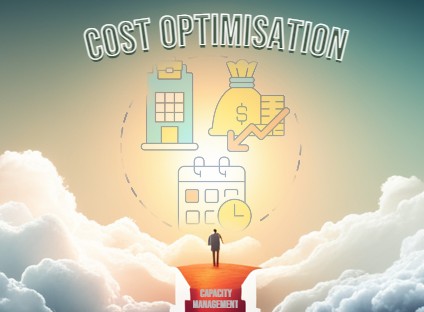Talk to our Experts
Our in-house experts have architected, designed, built and automated some of the UK's largest Enterprise Networks and Data Centres. We've probably:
- Networked it
- Designed it
- Automated it
Jul 03, 2023 itsm Twitter GitHub info@caci.co.uk
Capacity Management has been a stable of IT Service Management (ITSM) for many years, often historically associated with practices such as Just In Time (JIT) hardware provision to achieve Network, Storage or Compute low-watermarks which sustain Service Level Agreements (SLAs). However, as the move to commodified on-demand workload prevails - as enabled through Cloud and DevOps Provisioning practices - Capacity Management begins to become less optimal as a practice to sustain the delicate balance of cost versus performance for an IT System.

However, with the increased adoption of Cloud Native giving rise to OpEx, rental-based workload hosting over CapEx, ownership-based workload hosting, we're seeing a new contender for managing performance against cost in the IT Services space - Cost Optimisation.
Cost optimisation is the process of identifying and reducing sources of wasteful spending, underutilisation, or low return in the IT budget. The goal is to reduce costs while reinvesting in new technology to speed up business growth or improve margins. Mainly, it is a continuous process of identifying and reducing sources of wasteful spending and low return in the IT budget - and unlike Capacity Management, it focuses on System Architecture improvements and modifications, as well as the tweaking of Compute, Storage and Network levers, in order to achieve its goal.
In the Cloud context, Cost Optimisation often looks like a FinOps team, process or mandate, which is tasked with the following to achieve the cost reduction:
Much of this runs contrary to traditional Capacity Management practices, as the main vehicles of achieving these are often to go under the bonnet and actually rearchitect elements of how the IaaS or PaaS components operate to achieve the improvements in the upper-layer Application workloads. Cost Optimisation can be a great way to build a scalable, modern infrastructure that meets the demands of your workloads without going over budget.
Ideally, you want your Cloud Infrastructure costs to go flat or increase only marginally as your Client or installed Application workload base grows over time. But if your costs rise faster than - or as quickly as - you onboard Customers, you may have a problem. Cost Optimisation can help you identify areas where you can reduce costs and reinvest those savings in other areas of your Infrastructure or Business Operations.
Capacity Management has traditionally focussed on ensuring that IT systems have the resources they need to perform optimally, against a backdrop of on-premises IT where Baremetal was king and OpEx was reserved purely for Software Licensing concerns. However, this approach is no longer sufficient in today's complex IT environments, where ephemeral workloads and infrastructure elasticity mean it can be difficult to keep track.
Capacity Management isn't cutting it for your dynamic, Cloud-native workloads anymore. It is time to shift towards a more dynamic system of Resource Management through Cost Optimisation
By shifting from Capacity Management to Cost Optimisation, organisations can better align their increasingly limited IT spending with business priorities. This approach involves identifying areas where costs can be reduced without sacrificing the important Observability Pillars of Performance or Reliability.
Our in-house experts have architected, designed, built and automated some of the UK's largest Enterprise Networks and Data Centres. We've probably:
Being successful with Cost Optimisation initiatives requires a cultural shift - as enabled via DevOps and Agile Project Management practices - towards these best practices:
Cost Optimisation isn't a one-shot activity, it is an ongoing, continuous process to enable optimal business operations and garner cost efficiency. Cloud waste-reduction should always be the goal to finance growth in desired USP and differentiators
Gartner predicts Cloud spending to grow to almost $600 billion in 2023, with previous trends showing the Cloud TAM (Total Addressable Market) as having increased year-on-year at a rate of 20-30%. In 2026 it is estimated Public Cloud expenditure could be as much as half of all Enterprise IT budget spending. Unlike on-premises Infrastructure, which can be amortised and deprecated over time; Cloud spend tends to be ongoing Operational Expenditure (OpEx), and can often increase over time for a given workload as its use or Client base grows over time.
If you want those flat or diminished Infrastructure costs, this means you have to integrate Cloud Optimisation into your business processes and daily workflow; Cloud Optimisation isn't a "one and done" endeavour. Indeed, to be truly mature in Cloud Optimisation, we would advocate for FinOps practices to be engrained into the CI/CD Pipelines and ITSM Governance Gating processes - such as Design Board, CAB and ITDB - to truly treat it as a first-class citizen amongst other competing factors within the System Operation and Design.
Cost Optimisation should exist to answer these questions in providing value back to the Business:
At CACI Network Services we're well versed in using Cost Optimisation techniques to provide best-value for various types of Enterprise and Application Workload architectures, through our strong heritage in Network Infrastructure Engineering and Consulting.
Get in touch and let our experts start working alongside your FinOps Teams to tame your Cloud bills by imparting our Cloud Optimisation know-how and learnings from Industry.